|
|



Bryan Coffman
December 18, 1996
The Creative Process is one of the foundational MG Taylor models.
If I had to choose only six models to arm myself as a facilitator of enterprises
in transition, I'd choose the Seven Stages of the Creative Process, the Seven Domains of Collaborative
Design, the Stages of an Enterprise, the Business of Enterprise, the Ten Step Knowledge Management Process, and
the Vantage Points. With these six I can quickly analyze and prescribe for any organizational
situation, design any collaborative process, focus on what needs to be managed
to survive the transition, keep a finger on the pulse of creativity, manage
information, and keep the entire enterprise in perspective from philosophy to
task.
Each Knowledge Worker has their own preferred set of models
to work from, of course. My collection is not superior to others. However, if
you're somewhat new to MG Taylor, I can recommend these models as good starting
points, both to raise questions concerning our philosophy and methodology, and
to also develop your own models-based practice of transition
management.
For an introduction to the Seven Stages of the Creative Process
model, click here. For an explanation of the glyphs that describe each stage of the model,
click here.
How Many Stages to the Process? Only One...
There is only one stage in the true model of the Creative Process. At the simplest
level, creativity is the act of being and doing folded into a state of flow
called life. I claim that we naturally spend all of our time in a state of flow,
despite claims in the popular press to the contrary. Even when we're analyzing
a problem (in the Identity stage), we're DOING something (in the Building stage),
and employing tools of some sort (in the Using stage). We simultaneously embrace
a rapidly evolving picture of what we want to do that unfolds just before we
do it (in the Vision stage). See, it all folds together into one. What the popular
press describes as a state of flow occurs when the execution of the creative
process becomes jubilant, and consequently high performance.
We divide the Creative Process into pieces in an effort to understand and picture
the complexity of the entire process. But let's not fall into the trap of believing
that we actually execute the pieces in some sort of lock step fashion. It's
convenient and instructive to perceive that creativity has certain stages, and
that we can all emotionally, physically and mentally relate to these stages,
but to hold any model of the creative process as a precise description of creativity,
and to force others to adhere strictly to its application is foolish. Stuart
Kauffman uses an expression to describe the difficulty of modeling any living
system: "the algorithm is incompressible." In other words, there's
no shorter method, routine or program to describe life or living systems than
life or the living system itself. Models are representations of reality but
they are not the reality itself. There is no algorithm or equation that we can
force creativity into that is shorter than the creative act itself.
As we move forward in this investigation of creativity, let's do so with caution,
and after we have understood the descriptions, extract what is useful and valuable
for our own application. I will speak of the creative process as having many
stages and a directionality of their unfolding expression, but this is only
a primitive way of addressing a subject of manifold complexity. Creativity requires
many, many concepts to explain it, and it may be convenient and perhaps illuminating
to structure a handful of these concepts into a picture.
The Bipartite Model
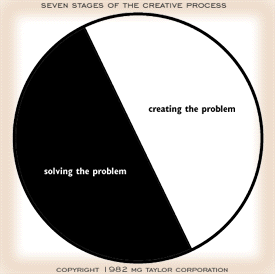 This simple division of the creative process into two pieces
is perhaps the most instructive for the transition manager as a diagnostic tool.
The idea that the first half of the creative process is "creating the problem"
startles many people. There's a tendency for all of us to think that we darn
well know what the problem is and that the real work needs to be exercised in
the realm of fixing what we already know. When I encounter a chronic organizational
problem as a transition manager, I test to see if the problem remains unresolved
because of a refusal to admit, or an ignorance of the necessity to create the
problem with as much rigor as will later be applied to solving it. This simple division of the creative process into two pieces
is perhaps the most instructive for the transition manager as a diagnostic tool.
The idea that the first half of the creative process is "creating the problem"
startles many people. There's a tendency for all of us to think that we darn
well know what the problem is and that the real work needs to be exercised in
the realm of fixing what we already know. When I encounter a chronic organizational
problem as a transition manager, I test to see if the problem remains unresolved
because of a refusal to admit, or an ignorance of the necessity to create the
problem with as much rigor as will later be applied to solving it.
CEO's, project managers, workers of all kinds are used to being handed problems
to solve. Many of these are somewhat straightforward. Think of these types of
problems more as maintenance than as engaging the entire creative process. We
can, after all, perceive recurring patterns inherent in the conditions of a
situation and apply tools that have worked in the past to change the conditions
from one state to another. This activity becomes so automatic that we may learn
to equate the initial conditions with the problem. Most of us have also been
conditioned by conventional education to accept problems from outside sources
unchallenged and then apply a set of tools to arrive at a solution. This is
one area in education where the liberal arts may be far in advance of science
and mathematics [this is not a personal bias at all; I'm a geological engineer
by background and an artist by avocation]. A student dancer, artist, or musician
is evaluated on their interpretation of a piece, as well as their technique.
Student scientists, on the other hand, are expected to all come up with the
same answer, although occasionally there may be quite a bit of invention displayed
in their approach. Interpretation only comes from taking the piece of music
in the case of the dancer and musician, or a physical landscape in the case
of the artist, as an initial condition and then formulating the problem from
it, which the artist solves through the medium of her tools, mind, spirit and
body.
We all observe conditions, not problems. We examine states of behavior of various
systems using our own peculiar tools and filters. We look at the world and attempt
to model it so that we may understand or resonate with how it works. So we hope
to enhance what we enjoy and mute what we dislike. The combination of an understanding
of the world along with our desire to bring certain components of it into fuller
expression creates the problem. The interplay of scanning, identifying, envisioning,
and developing a passion for bringing the vision to reality constitutes what
we call creating the problem.
Creating the problem is not taking ten minutes to brainstorm issues. Instead
it's building a model of how system components relate to one another in such
a way that reproduces the conditions or behavior of the whole system. Then it's
a matter of envisioning what changes to the SYSTEM COMPONENTS or their interconnectivity
will lead to a change in conditions. We can't adjust conditions directly by
force; we must be more clever than that.
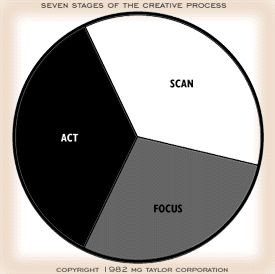 Perhaps you've seen the T-shirt with the three quotes from Plato, Aristotle
and Frank Sinatra. Plato's quote is "To be is to do," Aristotle's,
"To do is to be," and Frank's, "do be do be do." I've thought
this very clever, and in a funny way, it's applicable to the three stages of
the Creative Process as diagrammed to the left. The Scan stage is a realm of
being, of philosophy. What you do is the result of what you are. The Act stage
is a realm of doing where what you do determines what you are. In the middle
is this really uncertain space whose emotional content can't be better described
than with the words "do be do be do." In focus you don't quite have
all the pieces to actually do something in the new model, nor are you able to
be in the new model (or the old for that matter). It's a zone of paradox and
uncertainty. In paradigm shifts, it occurs when the enlightenment of insight
has seriously questioned the old way of doing and being, but has not resolved
all of the issues yet. This is a zone of struggle that many of us prefer to
avoid. After all, we went through that once during adolescence and we're not
willing to experience the unpleasant aspects of questioning and not knowing
again. Unfortunately, it is a zone that we should all frequent more often, not
merely to challenge any outworn beliefs and practices to which we cling, but
to even sometimes strengthen our current positions by stretching the range within
which these positions hold validity. Perhaps you've seen the T-shirt with the three quotes from Plato, Aristotle
and Frank Sinatra. Plato's quote is "To be is to do," Aristotle's,
"To do is to be," and Frank's, "do be do be do." I've thought
this very clever, and in a funny way, it's applicable to the three stages of
the Creative Process as diagrammed to the left. The Scan stage is a realm of
being, of philosophy. What you do is the result of what you are. The Act stage
is a realm of doing where what you do determines what you are. In the middle
is this really uncertain space whose emotional content can't be better described
than with the words "do be do be do." In focus you don't quite have
all the pieces to actually do something in the new model, nor are you able to
be in the new model (or the old for that matter). It's a zone of paradox and
uncertainty. In paradigm shifts, it occurs when the enlightenment of insight
has seriously questioned the old way of doing and being, but has not resolved
all of the issues yet. This is a zone of struggle that many of us prefer to
avoid. After all, we went through that once during adolescence and we're not
willing to experience the unpleasant aspects of questioning and not knowing
again. Unfortunately, it is a zone that we should all frequent more often, not
merely to challenge any outworn beliefs and practices to which we cling, but
to even sometimes strengthen our current positions by stretching the range within
which these positions hold validity.
The First Recursion: The Septpartite Model
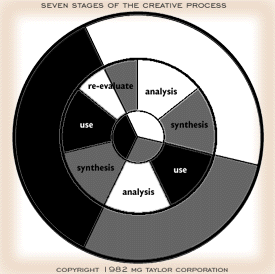 On top of the two part and three part models we layer a seven part
model. While we're creating the problem, we begin with a period of reevaluation
and analysis of what's going on and where we want to go. We build models of
what is and what we would like to be. Then we synthesize these models to build
our intentionality and our belief (at this point we're working on faith, not
understanding). This takes us into the focus stage where we use our synthesis
to gain hoped for insight and then analyze this insight to see if it will add
value. As this is being done successfully, the nature of the true problem to
be solved stands out clearly and we can begin work on its resolution. This takes
us into the realm of solving the problem and leads to the act stage. The first
element of the act stage is a synthesis of the steps that we will take in implementing
the solution, followed by the implementation (the use of the steps), and ending
with an evaluation of the efficacy of our work. This leads naturally to another
reevaluation of what has now become the new starting condition. On top of the two part and three part models we layer a seven part
model. While we're creating the problem, we begin with a period of reevaluation
and analysis of what's going on and where we want to go. We build models of
what is and what we would like to be. Then we synthesize these models to build
our intentionality and our belief (at this point we're working on faith, not
understanding). This takes us into the focus stage where we use our synthesis
to gain hoped for insight and then analyze this insight to see if it will add
value. As this is being done successfully, the nature of the true problem to
be solved stands out clearly and we can begin work on its resolution. This takes
us into the realm of solving the problem and leads to the act stage. The first
element of the act stage is a synthesis of the steps that we will take in implementing
the solution, followed by the implementation (the use of the steps), and ending
with an evaluation of the efficacy of our work. This leads naturally to another
reevaluation of what has now become the new starting condition.
Analysis, synthesis, use, re-evaluate is another way of looking at the Scan,
Focus, Act, Feedback model. What we've done in this recursion is to repeat the
model twice within a single pass of the creative process. Then we can speak
of two types of analysis: the subjective type found in the Scan phase, and the
objective type found at the end of the Focus phase. We can also begin to understand
that both the act of creating the problem and the act of solving it include
analysis, synthesis and use components. We can also begin
to discern one of the roots of conflict between members of collaborative design
teams. Two different individuals can both argue that they are analyzing a problem
but disagree with each other's approach. It's very likely that one of them is
analyzing from the Scan stage and the other from the Focus stage. The challenge
to the transition facilitator is crafting a design that allows these two vantage
points to mingle in such a way that a problem is created an solved in a superior
way, instead of deciding which vantage point should hold sway and then suppressing
the other.
The Second Recursion: The Standard Model
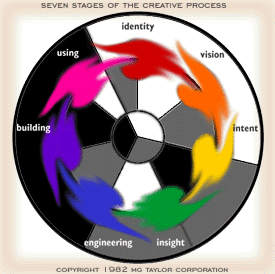 The standard model as usually drawn during DesignShop® events is
comprised of the seven stages, Identity, Vision, Intent, Insight, Engineering,
Building and Using. The Insight stage is divided in half by the bipartite model.
This is the realm where the problem is being created in final form and the solution
begins to reveal itself. Note also that the Intent phase marks the transition
from Scan to Focus and that the Engineering phase marks another transition from
Focus to Act. These three transitions mark the most unsettling portions of the
creative process and contain the most turmoil. We frequently talk in DesignShops
about the pendulum effect of swinging back and forth between intent and engineering
in the search for the right problem and the right solution to bring to it. Sometimes
the swings are more violent--between vision and building--but usually the most
diligent efforts to sort out the situation occur during the Focus phase. This
is the inventor's phenomenon, or "Edison's light bulb syndrome." Legend
(and it may be true) has it that Edison worked on nearly 1400 different approaches
before he got his light bulb to work up to the specs designated in his vision.
His Intent kept driving him to a solution, through each insight and each disciplined
and documented round of engineering. The standard model as usually drawn during DesignShop® events is
comprised of the seven stages, Identity, Vision, Intent, Insight, Engineering,
Building and Using. The Insight stage is divided in half by the bipartite model.
This is the realm where the problem is being created in final form and the solution
begins to reveal itself. Note also that the Intent phase marks the transition
from Scan to Focus and that the Engineering phase marks another transition from
Focus to Act. These three transitions mark the most unsettling portions of the
creative process and contain the most turmoil. We frequently talk in DesignShops
about the pendulum effect of swinging back and forth between intent and engineering
in the search for the right problem and the right solution to bring to it. Sometimes
the swings are more violent--between vision and building--but usually the most
diligent efforts to sort out the situation occur during the Focus phase. This
is the inventor's phenomenon, or "Edison's light bulb syndrome." Legend
(and it may be true) has it that Edison worked on nearly 1400 different approaches
before he got his light bulb to work up to the specs designated in his vision.
His Intent kept driving him to a solution, through each insight and each disciplined
and documented round of engineering.
The only time a group needs to step back to the Vision or Identity stage is
if it perceives that it's trying to create the wrong problem. Of course, in
actual practice, as one moves back and forth between Intent and Engineering,
the group will be updating their models developed in the Identity and Vision
stages. Remember that there's no lockstep approach to creativity. In practice
a group will bounce all over the model and determining where it is in the creative
process is more like taking a sampling of recent positions and finding a statistical
average than it is looking for the whole group to click from one step to another.
The Septpartite Model and the Standard Model
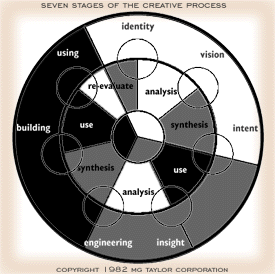 Just a note to observe that each stage of the standard model of the
creative process is bisected by one of the stages in the septpartite model.
Thus, Identity contains elements of evaluation and analysis. Vision involves
analysis and synthesis. Intent completes the synthesis and commences a use phase.
Insight is a deep, introspective use and analysis stage. Engineering is a testing
and experimentation stage involving cycles of analysis and synthesis. Building
synthesizes the work of engineering and uses it to create the final, tangible
product. The Using stage naturally uses this product and evaluates its efficacy. Just a note to observe that each stage of the standard model of the
creative process is bisected by one of the stages in the septpartite model.
Thus, Identity contains elements of evaluation and analysis. Vision involves
analysis and synthesis. Intent completes the synthesis and commences a use phase.
Insight is a deep, introspective use and analysis stage. Engineering is a testing
and experimentation stage involving cycles of analysis and synthesis. Building
synthesizes the work of engineering and uses it to create the final, tangible
product. The Using stage naturally uses this product and evaluates its efficacy.
Already some of the full complexity of the model is revealed. When attempting
to unravel a knotty condition in process facilitation, it can help to consider
the Scan-Analysis-Vision aspect of the condition. The facilitator may conceive
of a Scan level exercise that involves a subjective analysis of the individual
and collective visions of the participant. This would be much different than
a Scan-Synthesis-Vision exercise. Even though both exercises are in the Scan
and Vision stages, the shift from analysis to synthesis is critical, and important
for the facilitator to realize.
It's also possible, then to craft exercises that put some teams in Analysis-Scan-Vision
and other teams in Analysis-Focus-Engineering. The conjunction of analysis will
allow the teams to understand one another even though they're approaching the
problem from nearly opposite sides of the creative process.
The Third Recursion
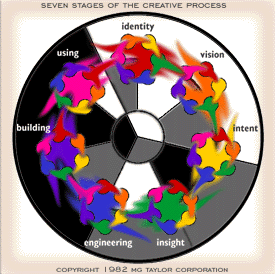 Each phase of the standard model is now considered an entire process
in and of itself. The Identity stage, for example, is now composed of the six
stages, Vision, Intent, Insight, Engineering, Building, and Using (represented
in the accompanying diagram by the small circles). The Engineering stage is
composed of the other six stages besides itself. Finally we can speak of Engineering
the Vision stage, or the level of Intent underlying the Building stage. This
third level of recursion is most useful as a prompt to change vantage points
when a group is stuck at some point in the process in general. It gives, for
example, six different paths for finding a way to forge ahead out of a stagnant
Vision stage. Maybe it's time to build a vision, or time to look for insight
concerning the vision, or maybe the group lacks intent. Perhaps the vision should
be used in some aspect to discover more about it. Each phase of the standard model is now considered an entire process
in and of itself. The Identity stage, for example, is now composed of the six
stages, Vision, Intent, Insight, Engineering, Building, and Using (represented
in the accompanying diagram by the small circles). The Engineering stage is
composed of the other six stages besides itself. Finally we can speak of Engineering
the Vision stage, or the level of Intent underlying the Building stage. This
third level of recursion is most useful as a prompt to change vantage points
when a group is stuck at some point in the process in general. It gives, for
example, six different paths for finding a way to forge ahead out of a stagnant
Vision stage. Maybe it's time to build a vision, or time to look for insight
concerning the vision, or maybe the group lacks intent. Perhaps the vision should
be used in some aspect to discover more about it.
The third recursion is also useful in very large projects with long durations.
In these cases, it's possible to actually discern the six stages of Insight
as a project passes through them. It also offers eighteen different patterns
to recognize as a group fights its way through the Focus phase of the project
from Intent through Engineering.
This level is sometimes useful in design, but it's easy to get bogged down.
Think of a team in the Engineering element of the Identity stage in Scan and
Re-evaluation. It's tough to wrap your thinking around these four axes at once.
But it is possible. One trick to doing so is to write a short paragraph that
describes a group in such a condition.
Imagine a team that is building a model of how an existing service delivery
process runs. They're trying to understand why customers have been giving them
such low satisfaction comments. Since they're building a model of the existing
process, they're in Scan. Because the model is focused on a lapse between performance
and expectations, they're in Re-evaluation. They're trying to get the model
to replicate the current conditions so they can look at the sub-components with
an eye to adjusting them; that's the Identity stage. They should be looking
at a variety of models, because the Engineering stage tells us to test different
variations before settling on one to build as the final model. With this understanding,
as a facilitator on the team, I can now write a series of assignments that helps
the team to assemble different models of the current process that produce the
same set of conditions, so we can piece them together into a more robust representation
of what's really going on. The team, for its part, can understand that at this
point in the process it's natural for members to have different understandings
of how the process is working, and how the components of the process' system
are linked together. In fact, we want to encourage such divergence at this time.
With experience and exploration it's possible to internalize this kind of analysis
(synthesize it...) and use it unconsciously with groups. And, of course, that
is the completion of one cycle of the creative process from the vantage point
of the facilitator.
The Fourth Recursion and Beyond
The full model of the Creative Process, as developed in 1982 contains yet a
further recursion to the process to reinforce the idea that the Creative Process
is extremely fractal. Many of our misunderstandings come from using the same
terms to describe vastly different portions of the process. There was an example
of this earlier in this paper. We now see that Vision
is a necessary component of each stage of the process. Some individuals will
prefer to approach a condition or a solution from the visionary's point of view,
and others will approach it from the engineer's. Yet others will take the administrator's
viewpoint and approach it as a builder. All of these vantage points are necessary
and useful. It is the job of the transition manager to help teams understand
the overlap of terms of art, the basic nature of the creative process, and the
challenges that recursion brings to collaborative design.

copyright © 1996, MG Taylor Corporation.
All rights reserved
copyrights,
terms and conditions
19961217225833.web.bsc
|

